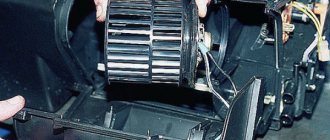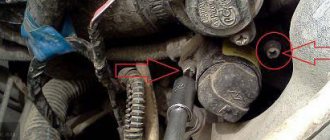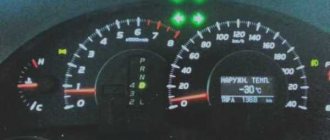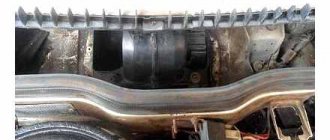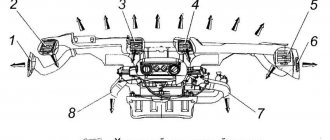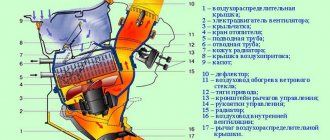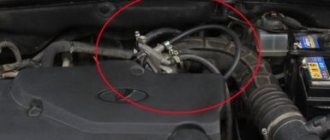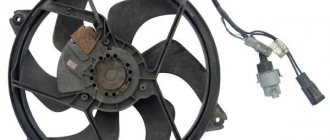As soon as the first cold weather arrives, some drivers are faced with a non-working stove in their VAZ 2110. The reasons may be different, malfunctions in mechanics and electronics.
To find out the causes of the breakdown and fix the problem, first of all you should study the Lada heating system and the essence of the stove’s operation.
In the course of their work, the mechanics were able to identify a number of the most common causes of a non-working stove on a VAZ 2110:
- the heater operates in one temperature mode at a certain speed or the temperature is not regulated at all;
- the shutters responsible for air distribution and then do not work;
- breakdown of the damper temperature sensor (located on the ceiling of the car);
- breakdown of the SAUO controller;
- Antifreeze heater radiator leaking.
Once all of the above points have been diagnosed and the cause of the stove failure has been determined, you can proceed directly to the repair.
Checking the operation of the automatic control system
To diagnose this system, you need to have a multimeter so you can measure the current on the pink and brown wires.
The voltage can have different values, it depends on which controller is built into the car. For example, in older cars - before 2002 - heater control controllers 1303.3854 were installed, in this case the voltage at the minimum position changes in about 14 seconds, and at the maximum value it is supplied stably. Therefore, if the voltage of the ACS unit at the output has a constant value, it is faulty. On newer cars since 2003, the built-in unit is 1323.3854, and the stove is 2111-8101012.
When faults are found in the controller, the dampers may be faulty. To determine other reasons for the breakdown of the car's 2110-12 heater, you will most likely need to disassemble the heater.
We identify the cause of the breakdown
First, you need to figure out the reason why the stove fan is not working. There may be several of them.
- A faulty fuse is the most common, simple and most common reason that the motor does not turn. On the one hand, replacing a fuse is not a big and difficult problem, which can be easily handled even by a beginner. But on the other hand, it will be necessary to find the reason why the fuse has become unusable. And to do this, you will need to examine the electrical circuit that ensures the normal operation of the heating system for the presence of a short circuit. Since we are talking about fuses, it would be useful to know that the operation of the stove on the VAZ-2110 depends on fuse F7 with a current strength of 30 amperes. Also, the operation of this fuse determines the illumination of the glove compartment, the functioning of the cigarette lighter, the electric motor from the headlight washer and the heated rear window. If a short circuit is not found in the electrical circuit of the heating system, then the cause will need to be looked for throughout the wiring.
- Problems with the contacts that are located inside the mounting block are a common reason for the VAZ heater motor not working. To identify this problem, you can move the block with the attached harnesses while the car is running. If the VAZ-2110 heater fan starts working, then it is necessary to remove the block and clean the contacts.
Diagnostics of heater system shutters VAZ 21I0
The VAZ 2110 stove has two shutters.
Through one, cold air is absorbed, and through the other, hot air is supplied. If the wire mechanism malfunctions, you may encounter the following disadvantages:
- The stove doesn't heat well
- There is no hot air flow at all,
- high air supply temperature,
- temperature is not regulated.
Shutters can have various types of breakdowns:
- It happens that the damper gets stuck or malfunctions, and the micromotor gearbox can also fail.
- Also, the damper may stop functioning due to rust, because there are two types of dampers.
There are old and modern samples of shutters,
- old ones - made of plastic and sealed with foam rubber,
- and modern ones are made of metal with a rubber seal.
If you cannot hear the damper operating, then try moving it after removing the deflector.
The disadvantage of metal dampers is that breakdowns often occur due to rust, while plastic ones tend to deform due to the supply of hot air.
In the case where the shutters do not move at all, diagnose the microdetector.
Design of the VAZ-2110 heater
The SAUO replaced manual control of the heater, but otherwise the stove remained structurally the same. As in earlier models, the interior heating system is a housing with a radiator installed inside, connected to the cooling system of the power unit - a heat source, dampers that redirect the air flow to the desired zones, and a fan driven by an electric motor, which creates the air flow. SAUO is a controller that, depending on the set parameters, monitors the temperature in the cabin and regulates the position of the dampers, maintaining the specified mode.
Video: Heater VAZ 2110; eleven; 12. Design and principle of operation.
The efficiency of the VAZ-2110 interior heater would be low without the forced creation of air flow, and this task falls on the stove fan.
Checking the micro-reducer of the stove shutter
To check the shutter drive, have an ohmmeter with you.
In old-style automatic control system controllers, the resistance at the minimum value of blue current should be from 850 to 1250 Ohms, in modern ones - 3.4-5.6 kOhms. If you want to check, you need to set the air supply temperature mark to the minimum value and hold for about 20 seconds. Disconnect the controller connector and, with the motor running, measure the difference in resistance in contacts XI.4 and XI.1. At the maximum temperature value in old controllers, the multimeter shows a resistance of 3.1 to 5 kOhm, in new ones - 1.3-1.5 kOhm. If the resistance does not change the readings or is absent altogether, this will indicate a malfunction of the micro-reducer shaft location sensor, which is associated with erasing the tracks, or a malfunction of the automatic control system itself, as a result of which no current flows to the micro-reducer.
In order to replace the micro-reducer you need to disassemble the stove.
Stove fan
Structurally, the fan consists of a DC electric motor with a commutator-brush assembly and an impeller mounted on the electric rotor. motor. The electric motor is powered from the vehicle’s on-board network. There are several modes of fan operation, the difference between which comes down only to the rotor rotation speed, and this is realized by inserting a resistor into the power supply circuit of the electric motor.
The fan operating mode is set using a handle located in the heater control unit on the center console. Initially, on the VAZ-2110, this handle was part of the design of the SAUO controller, but functioned separately from the controller itself. Later, the ACS added an automatic fan control function (position “A” on the handle), using which the controller regulates the rotation speed of the electric motor in order to maintain the set temperature.
The electric motor used in the design of the VAZ-2110 fan is simple, but it has “weak points” - the commutator-brush assembly and bearings. Wear of these elements causes incorrect operation and complete inoperability of the fan. Short circuits and winding breaks in the stove drive are rare, but don’t forget about these breakdowns either.
Symptoms of failure. Heater components that affect fan operation
Signs of a malfunctioning stove fan are quite obvious and impossible not to notice. Common symptoms of failure:
- Increased noise, grinding noise during operation.
- Significant reduction in air injection efficiency.
- The fan does not turn on.
- Spontaneous change in the rotation speed of the electric motor.
- It can be determined by ear that the electric motor is operating under heavy load.
In some cases, such consequences result from malfunctions in the power supply and fan control circuits, so you should check them first. This applies to:
- fuse (blowout is the cause of complete failure of the electric motor);
- resistor (if it is faulty, some speed modes of the electric motor stop working);
- controller (the knob for switching fan modes is part of its design, so malfunctions of the automatic control system affect the functioning of the electric motor);
- wiring terminals of the power and control circuits (oxidation, damage to wires is one of the reasons for a malfunctioning electric fan).
If diagnostics of these elements shows that they are in good working order, it is necessary to dismantle and repair the fan itself. But it can be diagnosed first.
Fan check
A check is done by directly powering the electric motor from the battery (we lay wires from the battery terminals and connect them to the power terminals of the motor) - operation under load, difficulty in gaining rotation speed, squeals and squeaks indicate wear of the drive components and the need to replace them. But if, even with direct voltage supply, the electric motor does not start, it is most likely that it has burned out or the windings have broken. Such faults are difficult to fix and it is easier to replace the entire unit.
Design features of the stove of the old and new models
The design of the electric motor of the stove on the VAZ-2110 is identical, but the fans and their location are different. On models of the first years of production, the electric fan is installed in the stove housing in front of the radiator and it is located horizontally (old-style stoves). Afterwards, the design was revised - the fan was already placed in the cabin filter housing and installed vertically (new model heaters).
Despite the design features, dismantling the fan is a simple operation and does not require complete disassembly of the stove.
On a VAZ-2110 with an old-style heater, to remove the electric fan you need to:
- Dismantle the frill.
- Remove the front wall of the niche in which the heater is located.
- Remove the back cover of the fan housing by first unscrewing the screws and removing the clamps.
- Disconnect the wiring from the fan and remove it.
As for models with a new type of stove, the technology for removing the electric stove fan on such cars is different:
- dismantle the “jabot” and the front wall;
- remove the air filter;
- unscrew the fastening of the filter housing to the stove body and separate them;
- disconnect the wiring;
- remove the filter housing together with the fan;
- dismantle the electric fan.
After removing the electric motor with the impeller, we disassemble it, perform troubleshooting, replace worn elements and put it back together.
Video: Replacing the heater motor (heater fan) VAZ 2110, 2111 and 2112
Common stove malfunctions and options for eliminating them
Owners of tens often encounter a problem when the heater in the vehicle does not heat well or has stopped working. With the onset of cold weather, you have to sort out the car’s heating system and look for the causes of malfunctions.
Finding the original source of the problem is not always very easy. Sometimes, in order to find and fix a problem, you have to check almost all parts of the vehicle’s heating system.
Parts of the heater of the VAZ-2110 car
To make troubleshooting easier, we will consider the main indicators of improper functioning of the stove, possible sources of malfunctions in each specific case and options for eliminating them.
Supplying a weak air flow into the car interior
Owners of VAZ-2110 cars are often faced with a situation where both warm and cold air is supplied to the cabin, but under very low pressure. Accordingly, heating or ventilation of the interior requires significantly more time than during normal operation of the heating system. If the heater does not blow well, the cause of this malfunction may be a clogged heater radiator or vehicle cabin filter.
We recommend: How to remove the secret from a car wheel without a key
First, you need to check the condition of the cabin filter of the car. In dozens, it is most often located behind the glove compartment on the passenger side. If it is heavily polluted, then air flows through it poorly and provokes problems with the interior heating system. Contamination of a car's cabin filter can be eliminated in two ways. The first is high-quality cleaning of the filter and installing it in its original seat. However, this method is less effective. The problem will reoccur a few weeks later. A more correct solution is to replace the cabin filter with a new product. Moreover, the filter must be changed every fifteen thousand kilometers or twice a year.
Cabin filter of the VAZ-2110 car, requiring replacement
If after replacing the cabin filter the problem does not disappear, then you need to check the condition of the heater radiator. This is more difficult to do, since you will have to disassemble almost the entire heater from the engine compartment side. Poor flow of coolant in the radiator can be caused by both small particles of debris that can get into it, and the formation of scale inside the product. Antifreeze leakage through holes in the radiator may also be the reason for poor operation of the stove.
If the radiator is clogged with debris or scale, the problem can be eliminated by washing the product with special means. If there is a coolant leak, experts advise immediately replacing the radiator with a new part. Fixing the problem by soldering the radiator will help solve the problem for a very short period of time, after which the antifreeze will leak out again and you will have to re-disassemble almost half of the engine compartment to install a new part. It is also necessary to immediately check the condition of the hoses and pipes that go to the heater radiator and, if necessary, replace them.
The VAZ-2110 stove blows cold air
Often, owners of domestic cars are faced with a situation where only cold air enters the cabin through the heater deflectors, regardless of the temperature setting. In most cases, the heater blows cold air after replacing or adding coolant. The cause of this malfunction is air entering the heating system of the vehicle.
If the coolant is replaced incorrectly, an air lock forms in the radiator pipes and hoses, which must be eliminated. This is not difficult to do. It is necessary to drive the car onto a hill or overpass, so that its front end is as high as possible. After this, you need to let the car idle for several minutes, periodically you need to gas it. In this way, the air lock can be expelled from the system.
Then you need to check the antifreeze level and, if necessary, add it to the required level in the expansion tank. Often, after carrying out such actions, the stove begins to work properly.
The temperature in the VAZ-2110 cabin is not regulated
Sometimes there are situations when the heater cannot be adjusted. Regardless of the position of the temperature regulator on the control panel, the stove either blows cold air or produces only a hot stream. Such discomfort may be caused by a malfunctioning temperature sensor or a failure of the heater damper.
You can check the operation of the sensor by turning the temperature regulator several times to the extreme maximum position. If the situation has not changed, then it is necessary to replace the sensor, which is located on the ceiling of the car, next to the ceiling light.
Temperature sensor in the passenger compartment of a VAZ-2110 car
Sometimes the VAZ-2110 stove does not heat up or only works at maximum speed due to a failure of the heater damper. In this case, it is necessary to remove the deflectors from the engine compartment, bend the fastening antennae and get to the valve. Often the damper gets stuck in one position, and it does not respond to the regulator inside the cabin. Then you need to try to move the stuck part. If it moves without effort, then the problem must be looked elsewhere.
The cause of the malfunction may be deformation of the damper due to high temperatures. Then it is necessary to replace the plastic valve that the car is equipped with from the factory with a more reliable aluminum part.
The heater damper micro-reducer may also be the culprit of the malfunction. If it fails, it will be impossible to adjust the temperature in the cabin. You can check this by removing the windshield trim and frill from the engine compartment. After this, it is necessary to test the movement of the damper lever when switching heater modes in the cabin. If the damper lever moves, then the micro-gearbox is working. Otherwise, it must be replaced.
If the VAZ-2110 stove does not work in any mode other than the maximum one, then the cause of the breakdown may be a failure of the heater resistor. The resistor may fail due to overvoltage in the network. The resistor is located on the right side of the stove. To replace it or diagnose it, it is necessary to dismantle the windshield cover and the vacuum booster. After this, using an ohmmeter, the resistance on the coils, which are responsible for converting the current into the required voltage for the correct operation of the heating system, is checked. If the indicators differ from the norm, then it is necessary to replace the product with a new resistor.
And also the problem may be in the disconnection of the fuse, which is located on the resistor board. In this case, you can eliminate the malfunction by soldering, however, you must first find the cause of the blown fuse. It may be in oxidized contacts or poor wiring insulation. Initially, you need to diagnose all elements of the heater's electrical circuit using a tester, find the weak link and eliminate the malfunction. Poor operation of the heater's electrical components can cause a short circuit or fire.
The VAZ-2110 stove does not work
If the stove on a VAZ-2110 has completely stopped working, this may indicate a failure of one of the elements of the heating system. In this case, to determine the cause of the malfunction, you will have to check the functioning of absolutely all parts of the heating system. This is a labor-intensive task and requires the performer to have certain knowledge of electronics. It is also necessary to understand the technology of functioning of the car’s heating system.
Diagram of the automatic heater control system: 1 – fan electric motor; 2 – additional resistor; 3 – controller; 4 – mounting block; 5 – ignition switch; 6 – cabin air temperature sensor; 7 – recirculation switch; 8 – recirculation valve; 9 – micromotor gearbox for heater damper drive; A – to the instrument lighting switch; B – to power supplies
Most often, the VAZ-2110 stove does not work due to a fan failure. It can be easily replaced with a new product. In second place is the thermostat, which is also replaced in case of malfunction.
We recommend: What to do if your diesel engine stalls
Failure of a vehicle's heater in most cases results in the need for major repairs. In this case, you need to calculate the possible costs of purchasing new parts and compare them with the price of a new stove. Experts recommend that if the stove fails completely, it should be completely replaced. Very often, the VAZ-2110 is equipped with stoves from the VAZ-2112 that are more advanced in design features and technical characteristics.
Fan replacement
If the problem still lies in the fan itself, then it would be best to replace it with a new one. The stove fan can, of course, be repaired, but this may involve, for example, replacing the brushes. It simply doesn’t make sense to carry out more comprehensive repairs, since you can’t hope for long-term service for such a part. Replacing a VAZ-2110 stove fan requires selecting a new part. There are two options here: find an old-style part or buy a new spare part. The second option is more acceptable and accessible.
The replacement process is not as complicated as it might seem. It is enough to be able to work with standard tools, have free time and have the desire to tinker with your own machine. To replace a faulty fan, you must follow the following work plan:
- Open the hood and remove the battery negative terminal.
- We remove the windshield wipers by prying and dismantling the rubber caps. Using a 10mm wrench, unscrew the nuts and remove the brushes.
- Using a slotted screwdriver, pry up the decorative plugs, unscrew the screws on the frill and the nuts on the edges. Now we can remove the frill.
- Under the rubber seal you can find screws that hold the shield from the engine compartment. We also unscrew them.
- We dismantle the hose through which washer fluid is supplied to the injectors.
- On the right side of the engine compartment, there are two nuts on the bottom side that fit a 10mm socket wrench. They are difficult to get to, but you don’t have to unscrew them all the way, because with a few turns the shield can be easily removed.
- It is necessary to remove the clamps from the hose that connects to the vacuum booster of the brake system in advance.
- There are four self-tapping screws on the cabin filter cover; after unscrewing them, you can easily remove it.
- Already at this stage the outlines of the stove motor are visible. But you will also need to disconnect the block on the heating system motor and on the resistor.
- After the work has been done, it becomes possible to dismantle the left side of the stove along with the motor.
- A new part is installed in place of the damaged element, and assembly is carried out in the reverse order.
If you have never had to remove a heating system fan before, this process may take several hours. But in the future, any problem with the heating system can be fixed much faster. Even if something doesn’t work out for you during your work, you don’t need to stop trying to achieve a positive result. Over time, everything will definitely work out.
Temperature is not adjustable
If you cannot adjust the temperature of the air supplied to the cabin, then you need to look for the reason in the damper or control unit. It is possible that the temperature sensor, which is located on the ceiling, next to the ceiling lamp, has failed.
To check it, you need to turn the regulator to the right all the way, then bring your hand to the air flow coming from the heating system. If warm air flows only when the regulator is in the maximum heating position, then the sensor itself (or even the regulator) needs to be changed.
If heat also occurs in other positions of the regulator (in the red part), then the sensor is not at fault.
After this, you need to check whether the damper is stuck. They approach it through the engine compartment: remove the central deflectors and move the damper by hand. If you have to remove it, it is better to replace the plastic one (it comes standard) with aluminum, which is not so prone to deformation and freezing.
An article dedicated to the repair of the damper in the VAZ 2110 is located here:
